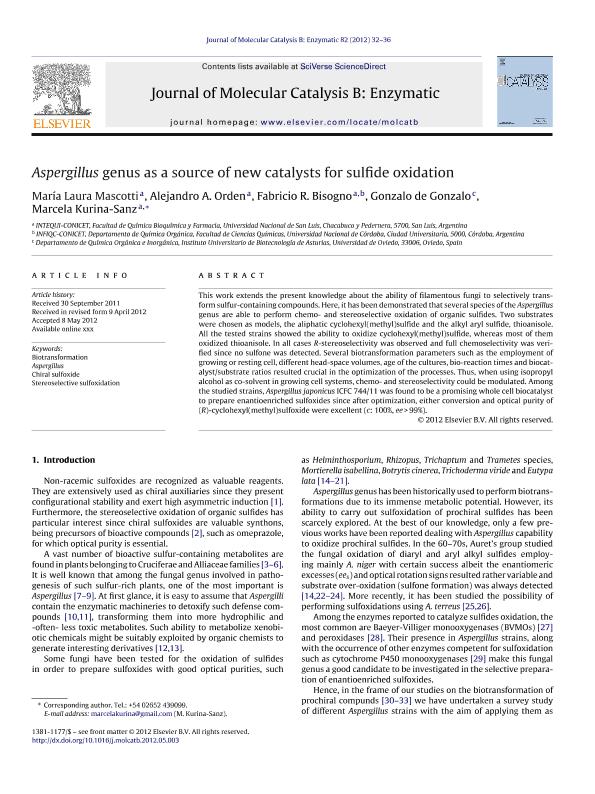Artículo
Aspergillus genus as a source of new catalysts for sulfide oxidation
Mascotti, María Laura ; Orden, Alejandro Agustin
; Orden, Alejandro Agustin ; Bisogno, Fabricio Román
; Bisogno, Fabricio Román ; De Gonzalo, Gonzalo; Kurina Sanz, Marcela Beatriz
; De Gonzalo, Gonzalo; Kurina Sanz, Marcela Beatriz
 ; Orden, Alejandro Agustin
; Orden, Alejandro Agustin ; Bisogno, Fabricio Román
; Bisogno, Fabricio Román ; De Gonzalo, Gonzalo; Kurina Sanz, Marcela Beatriz
; De Gonzalo, Gonzalo; Kurina Sanz, Marcela Beatriz
Fecha de publicación:
10/2012
Editorial:
Elsevier Science
Revista:
Journal of Molecular Catalysis B: Enzymatic
ISSN:
1381-1177
Idioma:
Inglés
Tipo de recurso:
Artículo publicado
Clasificación temática:
Resumen
This work extends the present knowledge about the ability of filamentous fungi to selectively transform sulfur-containing compounds. Here, it has been demonstrated that several species of the Aspergillus genus are able to perform chemo- and stereoselective oxidation of organic sulfides. Two substrates were chosen as models, the aliphatic cyclohexyl(methyl)sulfide and the alkyl aryl sulfide, thioanisole. All the tested strains showed the ability to oxidize cyclohexyl(methyl)sulfide, whereas most of them oxidized thioanisole. In all cases R-stereoselectivity was observed and full chemoselectivity was verified since no sulfone was detected. Several biotransformation parameters such as the employment of growing or resting cell, different head-space volumes, age of the cultures, bio-reaction times and biocatalyst/substrate ratios resulted crucial in the optimization of the processes. Thus, when using isopropyl alcohol as co-solvent in growing cell systems, chemo- and stereoselectivity could be modulated. Among the studied strains, Aspergillus japonicus ICFC 744/11 was found to be a promising whole cell biocatalyst to prepare enantioenriched sulfoxides since after optimization, either conversion and optical purity of (R)-cyclohexyl(methyl)sulfoxide were excellent (c: 100%, ee > 99%). © 2012 Elsevier B.V.
Archivos asociados
Licencia
Identificadores
Colecciones
Articulos(INFIQC)
Articulos de INST.DE INVESTIGACIONES EN FISICO- QUIMICA DE CORDOBA
Articulos de INST.DE INVESTIGACIONES EN FISICO- QUIMICA DE CORDOBA
Articulos(INTEQUI)
Articulos de INST. DE INVEST. EN TECNOLOGIA QUIMICA
Articulos de INST. DE INVEST. EN TECNOLOGIA QUIMICA
Citación
Mascotti, María Laura; Orden, Alejandro Agustin; Bisogno, Fabricio Román; De Gonzalo, Gonzalo; Kurina Sanz, Marcela Beatriz; Aspergillus genus as a source of new catalysts for sulfide oxidation; Elsevier Science; Journal of Molecular Catalysis B: Enzymatic; 82; 10-2012; 32-36
Compartir
Altmétricas



